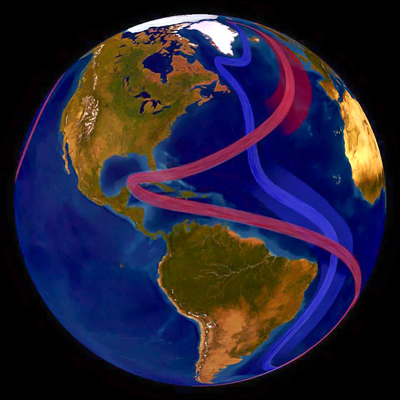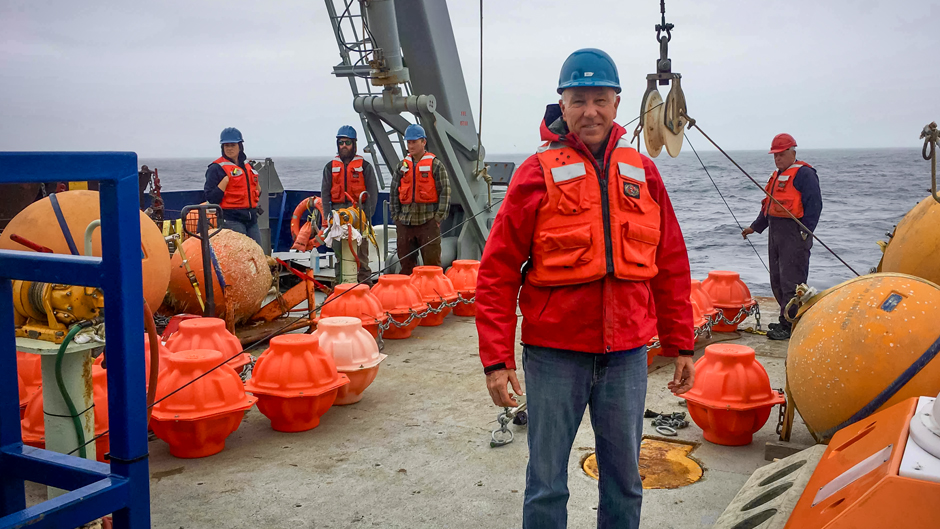Like the 60,000 miles of arteries and veins that course throughout the human body, ocean currents are the lifeblood of our planet—some flowing short distances, others circling the globe, but all playing a critical role in regulating climate.
One of the most complex system of currents, the Atlantic Meridional Overturning Circulation, or AMOC, is a global conveyor belt, distributing heat throughout the Atlantic by carrying warmer waters north and cooler waters south.
“For the Earth’s climate to remain in equilibrium, there has to be a huge transport of heat from low to high latitudes by the combined atmospheric and oceanic circulations,” said William Johns, a professor of ocean sciences at the University of Miami Rosenstiel School of Marine, Atmospheric, and Earth Science, who uses long-term moored instrumentation to study ocean circulation. “In the northern hemisphere, the AMOC accounts for nearly 25 percent of that heat transport on a global basis. It is unique in the global oceans because the Atlantic is the only place where warm surface waters move northward all the way from the tropics to polar latitudes and are cooled and sink to great depths.”
Those deep waters, he explained, then move southward underneath the warm layer, forming a meridional “overturning” circulation that scientists call the AMOC.

“The amount of heat it carries is almost unimaginable to most people,” said Johns, noting that the value is a little over 1015 watts. “That’s a 1 followed by 15 zeroes, or a quadrillion watts, which is about 100 times the total global energy production on Earth from all power sources.”
But is the AMOC, which affects patterns of drought and flooding, headed toward a collapse by the middle of this century? A recent study by a team of scientists from the University of Copenhagen and published in the journal Nature Communications warns that under the current pace of planet-warming greenhouse gas emissions, a shutdown of the AMOC could occur any time from 2025 to 2095, setting off rapid weather and climate changes around the world.
Johns, who has been studying the AMOC for nearly 20 years, going out to sea on research expeditions that can last as long as a month, answers questions about the Copenhagen study and provides an update on his own research related to this vitally important system of ocean currents.
How did the scientists in the Nature Communications study arrive at their conclusions?
There are several assumptions that are linked together in that study to arrive at the conclusion that an AMOC collapse is likely coming this century. First, they use a proxy for the AMOC strength based on sea-surface temperature (SST) changes in the subpolar North Atlantic, since our directly measured records of AMOC strength, available since 2004, are not nearly long enough to provide a basis for their analysis. That SST proxy involves a so-called “cold patch” in the area south of Greenland, which is one of the few places in the world’s ocean that is not showing continuous warming as atmospheric CO2 concentrations rise.
How accurate is the study? Is there anything to be concerned about in its methodology?
The problem is, we still do not know for sure that this SST proxy is definitely related to the strength of the AMOC. There is support from coupled climate models that it is, and the mechanism makes sense—that a reduction in the AMOC reduces the northward heat transport in the Atlantic and results in a relative cooling of the subpolar North Atlantic with respect to the global average SST. However, while most of those models do show a correlation between the cold patch and the AMOC, that correlation is dominated by the long-term trends in each one, and there is no evidence that shorter term variations in the cold patch on interannual to decadal time scales are closely linked to changes in the AMOC. In fact, in the model studies published so far on this, it looks like there is very little correlation between the cold patch index and AMOC changes on these shorter time scales. Yet, that is a critical assumption in the study, since they are basing their warning of an AMOC shutdown on the changes in the amount of variability of that SST proxy on those same time scales. To my knowledge, this analysis of short-term linkages between the cold patch and AMOC changes in the coupled models has not been done, nor was it considered by the authors. This, in my opinion, is a logical flaw of their model.
Second, their study is based on the foundations of transition theory in non-linear systems, where an instability of the system is indicated, in part, by increasing variance (i.e., volatility) that can lead to a tipping point to a new quasi-stable state—in this case, a complete shutdown of the AMOC. However, there are no physics in their model; it is simply mathematical modeling based on the time history of a particular quantity—in this case, the time history of the cold patch SST index. To make an analogy to something that may be more familiar to people, it is somewhat similar to certain kinds of technical analyses in stock markets, where increased volatility often presages a major transition or a major market decline. But those models are obviously far from perfect, otherwise everybody doing it would be insanely rich by now. I personally have a hard time believing that an analysis based simply on the past behavior of a quantity can provide such a robust prediction of its future behavior.
How important is the study as a warning sign about the dangers of climate change?
We have a lot to worry about regarding the future of the AMOC, since we know that both global warming and one of its major consequences—the increase in sea and land ice melting in the Arctic—will tend to slow down the AMOC and could lead to an eventual tipping point. The threat to the AMOC is just one of many highly undesirable outcomes from our continued reliance on fossil fuels, for example, ocean acidification, and ocean de-oxygenation and global heat waves, to name just a few. This study is just one more warning that we need to rapidly change our behavior as a human race to avoid potentially catastrophic consequences.
The AMOC is indeed weakening. What’s causing it to weaken, and what would be the result of its collapse? Would we see the type of rapid catastrophic climate and weather conditions portrayed in the movie The Day after Tomorrow?
Not quite on that time scale. The changes would likely occur over many years to decades rather than just a few weeks. The ocean has a lot of heat stored in it and that helps to buffer the climate system. However, the impacts of an AMOC collapse or major slowdown are widely known and are generally robust outcomes of climate projection models. They include a significant cooling in the North Atlantic and across the whole Northern Hemisphere, and a pooling of heat in the tropical and South Atlantic, which could lead to more intense tropical storms. There would also be major shifts in global precipitation patterns, which could create severe drought conditions in certain areas and devastating flooding in others. One of the most immediate and worrisome impacts would be a substantial sea level rise, of up to a foot or more, along the U.S. East Coast if the AMOC were to suddenly collapse.
Go into detail about your own AMOC-related research and what you’ve discovered.
I’ve been involved in the Rapid Climate Change-Meridional Overturning Circulation and Heat Flux Array (RAPID-MOCHA) project since it began in 2004, and also with OSNAP (Overturning in the Subpolar North Atlantic Program) since that began in 2014. In both these projects, we collaborate with investigators from other nations to deploy out arrays of deep-ocean moorings that allow us to continually monitor the strength of the AMOC. In RAPID-MOCHA, we have observed a general decline of the AMOC over the nearly 20 years we have been making those measurements, but we are not certain yet how much of that is related to global warming versus natural variability on decadal time scales.
These observational programs are intended to provide benchmarks for global climate models, to test their ability to simulate the AMOC and its variability, and to help validate their predictions. The observations also help to understand the physics of the natural variations in the AMOC so that they can be separated from the long-term AMOC variations associated with climate change.
What upcoming AMOC-related research cruises will you be taking?
We will be going up to Iceland to stage the next OSNAP cruise in summer of 2024, and then we will go back to the area east of the Bahamas for our next RAPID-MOCHA cruise in early 2025. We typically rotate our deployed equipment approximately every two years, which is about as long as we can keep things running reliably before the instruments need to be refurbished and recalibrated.
How long do your scientific cruises typically last, and what are some of the challenges you and other researchers face during your research cruises?
We are typically out at sea for several weeks to a month on research ships that are about 200 feet long, living and working in relatively small spaces. So, there are close quarters between the ship’s crew and the scientists onboard, and we work around the clock, 24/7. There is an old tongue-in-cheek saying that “going to sea is like going to jail, but with the added risk of drowning.” One of the major challenges is to maintain good camaraderie between all parties so that everyone works as a team to accomplish the goals, even under sometimes stressful circumstances, and to use the available amount of ship time we have as efficiently as possible. Weather is also a big challenge on some cruises, where during bad storms we can be shut down for periods of days at a time without being able to work. We typically factor in a few “weather days” for contingency, but you never know what you’re going to get, and it sometimes forces us to make hard decisions about what science we have to prioritize and what we simply don’t accomplish.
What types of instruments do you deploy.
Our moorings usually go from near the surface all the way to the bottom, some of them in more than 5000-meter water depth. The moorings themselves are up to 3.5 miles long, and we attach various instruments to them—mainly current meters, acoustic velocity profilers, and temperature/salinity/pressure recorders—that measure ocean conditions at a set of pre-determined depths in the water column. Safety is always a major concern, especially on our cruises where we are deploying heavy equipment over the side, such as huge floats and 5000-pound mooring anchors made of stacks of railroad wheels.

